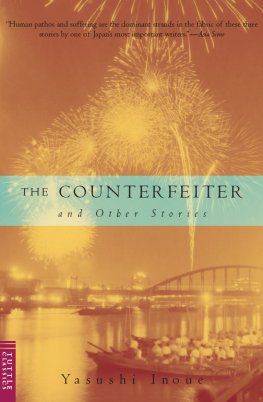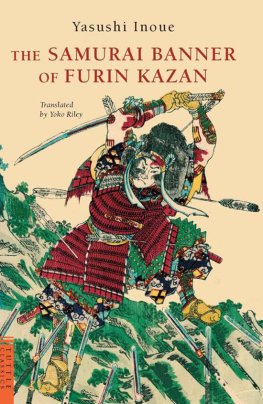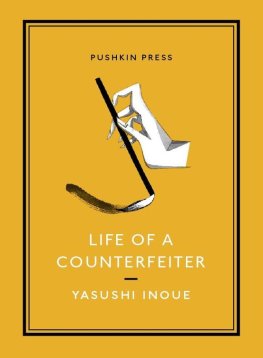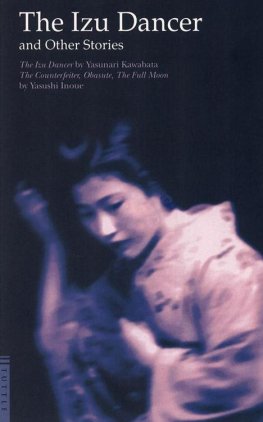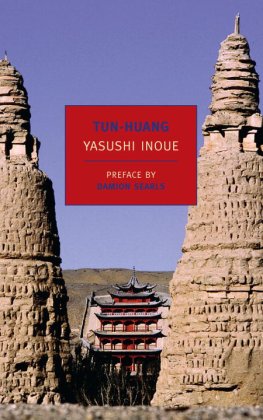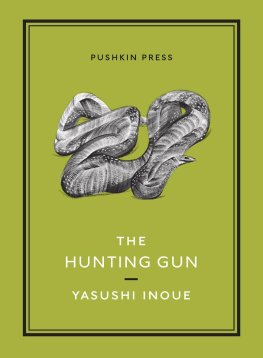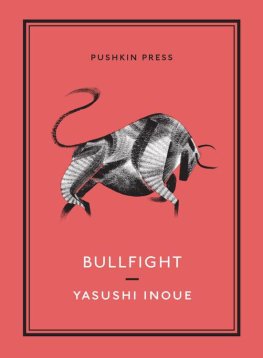Yasushi Inoue - Counterfeiter and Other Stories
Here you can read online Yasushi Inoue - Counterfeiter and Other Stories full text of the book (entire story) in english for free. Download pdf and epub, get meaning, cover and reviews about this ebook. year: 2000, publisher: Tuttle Publishing, genre: Prose. Description of the work, (preface) as well as reviews are available. Best literature library LitArk.com created for fans of good reading and offers a wide selection of genres:
Romance novel
Science fiction
Adventure
Detective
Science
History
Home and family
Prose
Art
Politics
Computer
Non-fiction
Religion
Business
Children
Humor
Choose a favorite category and find really read worthwhile books. Enjoy immersion in the world of imagination, feel the emotions of the characters or learn something new for yourself, make an fascinating discovery.
- Book:Counterfeiter and Other Stories
- Author:
- Publisher:Tuttle Publishing
- Genre:
- Year:2000
- Rating:5 / 5
- Favourites:Add to favourites
- Your mark:
- 100
- 1
- 2
- 3
- 4
- 5
Counterfeiter and Other Stories: summary, description and annotation
We offer to read an annotation, description, summary or preface (depends on what the author of the book "Counterfeiter and Other Stories" wrote himself). If you haven't found the necessary information about the book — write in the comments, we will try to find it.
Counterfeiter and Other Stories — read online for free the complete book (whole text) full work
Below is the text of the book, divided by pages. System saving the place of the last page read, allows you to conveniently read the book "Counterfeiter and Other Stories" online for free, without having to search again every time where you left off. Put a bookmark, and you can go to the page where you finished reading at any time.
Font size:
Interval:
Bookmark:
Yasushi Inoue
Counterfeiter and Other Stories
INTRODUCTION
HUMAN pathos and suffering, loneliness and isolation, Oriental fatalism and Buddhistic concepts of predestination form dominant strands in the fabric of virtually all of the writings of Yasushi Inoue. Probably his own separation from his parents when he was a child set the pattern for the basic framework of these moods, particularly that of loneliness. Here, it is perhaps interesting to note that the usual Japanese word for loneliness, kodoku, is made up of two Chinese charactersko, "orphan" and doku, "alone." And Yasushi Inoue as a child was an "orphan alone" in almost every sense except the legal one.
Born in 1907 the son of an Army physician in Hokkaido, the northernmost of the four major islands that comprise Japan, Yasushi Inoue was taken during his infancy to live with his grandmother in a small village on the Izu Peninsula, some hundred and thirty-five miles south of Tokyo. This area is obviously dear to him; he calls it "my native Izu Peninsula" in The Counterfeiter and opens Obasute with references to his childhood there. One cannot help but feel that his delicate sensitivity to all natural beauty harks back to that time when separation from his family and personal loneliness led him, even as a child, to seek solace in Nature, which surrounded him in that mountain village. While separation and isolation strike gloomy chords throughout Inoue's works, it is to natural and other visual beauty that he inevitably turns for release, comfort, and meditation. It is one of the characteristics of his style to ease his readers down to earth again after the more dramatic sections of his stories by some gentle description of natural beauty.
This sensitivity to beauty appears to have been highly developed in the young Yasushi by the time he entered college and probably much before that. Although according to the dictates of filial duty he should have followed in his father's footsteps and become a doctor, science held no interest for him and he majored instead in aesthetics during his collegiate years at Kyoto University. It was probably during these years that the three persistent themes of the writings of Yasushi Inoue developed: a deep and abiding interest in Chinese history, stemming from his studies of Oriental art and particularly its Chinese antecedents; an ever-present consciousness of art and artists (many of his stories deal with artists and their works); and an involvement with social problems, present and past.
Inoue, who is one of Japan's most prolific writers today, started relatively late as a novelist. He was forty-two when he published in 1949 his first works, the two novelettes Ryoju* and The Bull Fight, which the following year won for him the top literary prize in Japan, the Akutagawa Prize. His longer Tiles of the Tempyo Era (1957) deals both with art and ancient China; Lou-Lan** and The Flood*** are short historical novels of China. Whether he is writing full novels, novelettes, or short stories, however, Inoue's penchant for detailed, exhaustive research and historical accuracy give his stories a flavor of authenticity. Even the characters in his stories can often be traced back to historical individuals. In the spring of 1964, Inoue went to the United States to start his research on what he personally believes will be his magnum opus, a multi-volume treatment of first, second, and third generation Japanese abroad, particularly in the United States.
Prior to his emergence as one of Japan's most prominent literary figures, Yasushi Inoue worked as a reporter for the Mainichi Skimbun in Osaka. In two of the stories in this book there are specific references to his employment as a newspaper man. One wonders if the dissatisfaction with newspaper work which he attributes to his brother in Obasute is not really autobiographical, for Yasushi did, as he relates in The Counterfeiter, resign from the Mainichi Shimbun and move to Tokyo shortly after his initial successes in literature with Ryoju and The Bull Fight. During the war, he did in fact move his family to Tottori Prefecture, the main setting for The Counterfeiter. There are a myriad of other authentic autobiographical references to himself, his childhood, career, and character in all three of the stories in this book. He attributes to Toyama in The Full Moon some of his own attitudes toward human destiny, attitudes shaped in both cases by separation from parents at an early age.
The impact of his own separation from his parents is a constantly recurrent subject to which he alludes directly or indirectly, for it had a powerful influence on his personal reflections and on his reactions to all mankind. In the beginning of Obasute, when speaking of his childhood, Inoue writes, ". . but what I do recall in my faint memory is that my grandmother or was it my mother? anyhow, a member of my family. ." came out onto a porch to comfort him. "Just a few words" of comfort, he writes, and one is impressed that the neglect he felt as a child has stayed with him, a haunting reminder of his isolation and loneliness. In all three of the stories in this volume, separation occurs: a husband from his wife, a child from a parent, a sister from a brother, a mother from her two children. These are sorrows which in Inoue's case are felt with deep intensity. They are coupled with cold and gloomy darkness, slag heaps, and shadows "like spilled ink" an expression he uses in both Obasute and The Full Moon.
Inoue's training in aesthetics and his experience as a reporter would seem to have had marked influences on his style as a writer. Just as his work as a newspaper reporter was probably responsible for his lengthy research into detailed data before writing his stories, his exposure to Oriental art shows through in his descriptive powers. Like a sumie-painter who suggests forms with subtle brushstrokes, Inoue has a highly developed skill of portrayal through the least suggestion. His economy of language enables him to present intense drama and complex human involvement even in his shortest stories. But, even more, his characters ring true and are made real and vivid through just the slightest possible descriptive statements.
He wastes little or no time on the physical characteristics of the figures in his stories, and even his references to their personalities are generally encompassed in a single sentence, a phrase or a word. Of course, this sometimes has engendered the criticism that he tends to deal in stereotypes. Yet, even if he evokes stereotypic images, this technique in itself adds further credence and reliability to the authentic situations with which he deals. Inoue is one of the most precise writers in contemporary Japan. Given the lack of precision in the Japanese language itself, the precision in his choice of words is quite astounding. Stylistically, two main currents are constantly at work in his writings: a tendency toward long, involved descriptive sentences, with a host of modifying clauses and phrases each of which has its clearly directed purpose of elaboration of detail, and a tendency toward the compactness of individual phrases characteristic of Japanese poetry. Inoue, in fact, had aspirations of becoming a poet before his success as a prose writer, but he freely admits to failure as a poet. Be that as it may, if economy of words is one of the prerequisites for good poetry, in that respect much that is contained in Inoue's fiction is poetry of the highest order, but unhampered by the tyranny of form that pervades so much of Japanese culture.
The three stories assembled here reveal yet another facet of Yasushi Inoue his great compassion for his fellow human being. The tragic Hosen Hara in
Font size:
Interval:
Bookmark:
Similar books «Counterfeiter and Other Stories»
Look at similar books to Counterfeiter and Other Stories. We have selected literature similar in name and meaning in the hope of providing readers with more options to find new, interesting, not yet read works.
Discussion, reviews of the book Counterfeiter and Other Stories and just readers' own opinions. Leave your comments, write what you think about the work, its meaning or the main characters. Specify what exactly you liked and what you didn't like, and why you think so.

